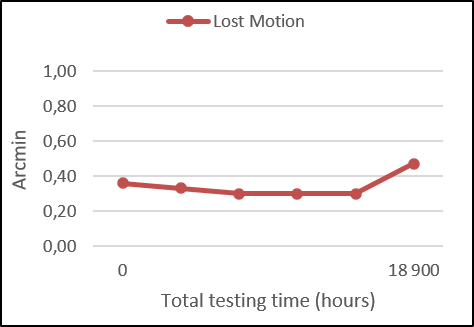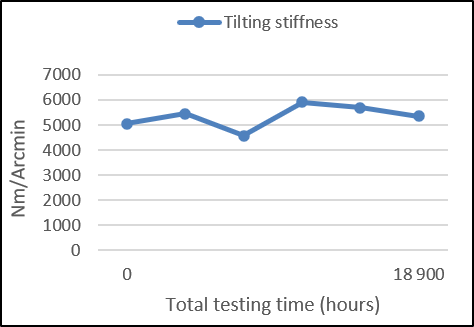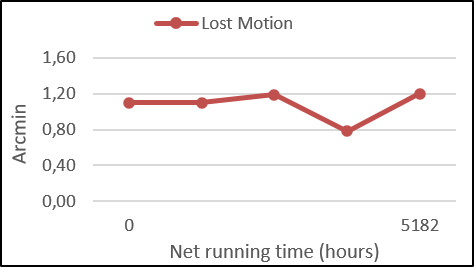
Do you know which component is the most important one in the reduction gear TwinSpin®? We give you just a hint: the component is not made of steel or any metal, and it is usually not in a solid-state.
If you guess it is a lubricant, you are right! No gear would work without lubricant and if, it would be a rather short time of existence. Lubricant determines the application areas of gears and proper selection of lubricant significantly influences the functionality of equipment that the gear is installed in.
The Alimentary or Food industry is an important industrial branch that has currently reported an automation boom. The number of applications in the food industry in which robots have replaced human work has been increasing. The agricultural industry represents another industrial sector with an increasing automation rate that concurrently processes food products. This sector uses various robots – driven equipment intended for harvesting and handling the crop, and also another type of robots used in processing semi-products in animal and plant production. While health and food safety is a priority in these sectors, high attention is paid also to the high performance of the equipment that ensures economical operation and helps increase work effectiveness.
Almost all equipment currently used in food processing require lubricant, but not the standard one. Food industry devices require food-grade lubricants.
Food – grade lubricant must meet demanding technical requirements, just like other lubricant types. It must provide protection against wear, reduce friction, remove heat, protect against corrosion, resist oxidation and aging, and be compatible with the sealing. Compared to commonly used industrial lubricants, the food-grade lubricants must meet standards established in the food industry. It must be healthily harmless, non-toxic, tasteless, and odorless.
Standards established in the area of food-grade lubricants are defined by NSF /global organization for standards in the area of public health/. Lubricants are classified by NSF in the following categories according to the use:
H1 lubricants – lubricants classified in this category may randomly come in contact with food products within the production process. All compounds of the lubricant, e.g. base oil, additives, and maximum allowed lubricant content in food are strictly regulated. Lubricants in this category are subject to mandatory publishing in the list of H1 lubricants
H2 lubricants – lubricants classified in this category are used only in food processing equipment where lubricants cannot come in direct contact with food. Such lubricants are not considered “true” food–grade lubricants and their regulation are not as strict as in the case of category H1.
TwinSpin & food-grade lubricants
Lately, SPINEA® has made big efforts and spent time with food-grade lubricants testing in order to select the most suitable lubricant types for all sorts of alimentary applications with installed reduction gears TwinSpin®.
Internal tests were focused on the following:
- The lubricant must be of category H1,
- The lubricant must be compatible with the sealing used in reduction gears TwinSpin®,
- Testing must be done in accordance with standard test conditions like in the case of other industrial gear lubricant types.
The majority of TwinSpin® applications are determined for robotics. Therefore SPINEA® chose standard robot test cycles for reduction gears testing, and also types and parameters of reduction gears commonly used in robot applications.
In the initial stage, SPINEA® conducted tests of lubricants on hollow shaft type of bearing reduction gear TwinSpin® 245 GH. Two reduction gears were tested in the standard robot cycle. Overall, the time of testing reached almost 19 000 hours.
Graphs No. 1 and No. 2 show values of the Lost motion parameter in time.
|
Graph No. 1 – reduction gear 1 |
Graph No. 2 – reduction gear 2 |
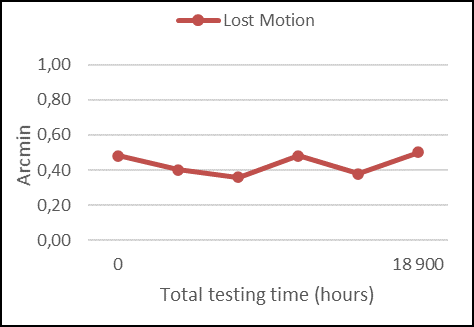
TwinSpin® reduction gear contains also integrated output bearing and tilting stiffness was checked during and after tests as well. Results are shown on graphs No. 3 and No. 4.
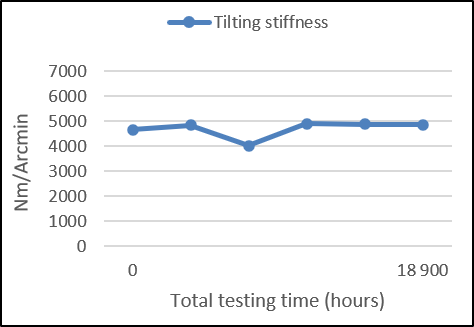
|
Graph No. 3 – reduction gear 1 |
Graph No. 4 – reduction gear 2 |
As shown in the above graphs, both reduction gears reached the determined testing time without significant loss of the main parameters. The result indicates a good condition of the gearing mechanism and the main bearing over time.
Small reduction gear TwinSpin® 85 with low gearing ratio represented another tested gear size. The stated test cycle is similar to the cycles used in the delta robots. The test was aimed at reaching 100 million cycles within the time frame.
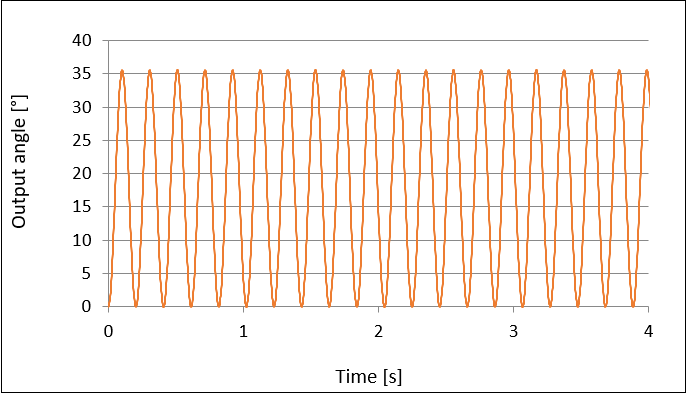
|
Graph No. 5 – reduction gear 3, test cycle |
Graph No. 6 – reduction gear 3 after 100 million cycles |
Conclusion
The above graphs indicate that the tested reduction gears maintained the Lost Motion parameter without significant increase, and tilting stiffness without major decrease during the whole test time and afterward, which confirm the excellent condition of the reduction mechanism and output bearing.
Tests of both reduction gear sizes were conducted:
- In standard test cycles for robot applications,
- Without torque reduction for the given test cycle,
- Without reduction of speed defined for the given test cycle,
- For a required length of calculated operating life.
SPINEA® is ready to offer our customers the reduction gears TwinSpin® with Food-grade lubricant with the same performance parameters as with standard industrial gear lubricants – simply without compromise.
If you found this article interesting and wish to get more information about TwinSpin® reduction gears and Food-grade lubricants, please contact the Sales Department of SPINEA® at e-mail address sales@spinea.com.
Our representatives will be glad to assist you in the selection of a suitable size and design of the reduction gear application for your equipment.


 SK
SK DE
DE IT
IT RU
RU CN
CN